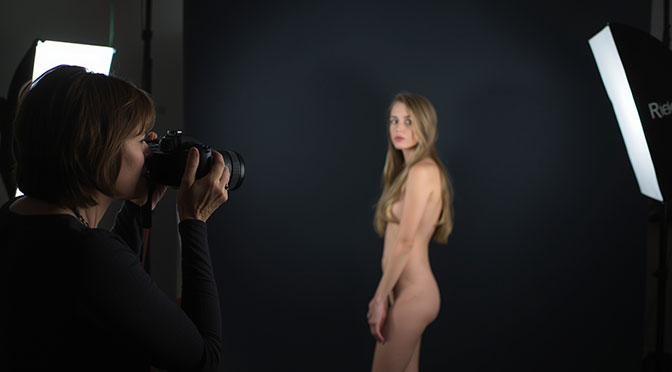The gaze as possession
Since art exists, the male gaze has shaped how women are seen.
It frames, judges, illuminates — always from the outside.
In painting, film, and literature, women’s bodies have been shown not as they feel, but as men imagine them.
The traditional Male Gaze is not just a look; it’s a structure of power. It turns the body into a surface, desire into display, and pleasure into ownership.
When a camera follows a woman’s hips, when a narrator tells us she “moves without realizing,” control belongs to the one who watches, not the one being watched.
Eroticism, in that model, is possession.
It only works as long as she doesn’t look back.
When the gaze returns
The Female Gaze begins the moment the observed returns the look.
It is not a mirror version of the male gaze; it’s a disruption.
It asks not, What does she look like?
but, What does it feel like to be seen?
Example:
A woman stands naked before a steamed-up mirror. She wipes it clear with her palm. The text does not describe her body but her sensations — the weight of the air, the warmth of her skin, the mixture of strangeness and intimacy in her reflection.
That’s the Female Gaze: interiority rather than observation.
Another scene:
A photographer asks her model to undress. She looks through the lens, not to control, but to understand how closeness feels when it’s chosen.
The erotic charge comes not from exposure, but from consent.
From object to subject
In the Male Gaze, the woman reflects desire.
In the Female Gaze, she expresses it.
That shift changes everything — not only how she’s described, but how she exists in the narrative.
A Female Gaze isn’t limited to female writers.
A male author can also adopt it by asking, How does she experience this moment — physically, emotionally, psychologically?
When the body becomes perception rather than surface, the text breaks free from the old frame.
The new eroticism of consent
The Female Gaze introduces a different tension: not between dominance and submission, but between self-image and visibility.
A woman who looks at herself writes a new chapter of her own representation. She is no longer what is seen — she is the act of seeing.
Eroticism becomes less about conquest and more about communication.
A gaze can seduce, but it can also draw a boundary. The difference lies in who narrates it.
For your writing
When you write from a female perspective, let the gaze breathe.
It can desire, but it can also pause, hesitate, reflect.
Show what she feels when she realizes she’s being watched — not just what she looks like.
And if you’re writing as a man, ask yourself the same question: What happens when her eyes meet yours?
The Female Gaze doesn’t silence men.
It simply gives women the right to define what they see — and how they are seen.
Writing Prompt
Write a scene in which your protagonist looks at someone — and that look changes what is possible between them.
Don’t describe her; let her describe.
The power of the scene lies not in the body, but in perception.

